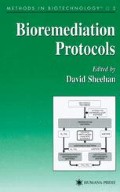Abstract
Alkenylbenzenes, such as α-methylstyrene,β-methylstyrene, and styrene, are produced in large quantities by the petrochemical industry (Fig. 1). The majority of studies have concentrated on the simplest of all alkenylbenzenes, styrene. It is a colorless, odorous liquid used both as a starting material for synthetic polymers and as a solvent in the polymer processmg industry. Airborne gaseous emissions of styrene are of particular importance because of malodorous properties of the compound and its potential toxic and carcinogenic properties. Personnel mvolved in the manufacture of glass-reinforced plastics and large-scale boat building are at the greatest risk of exposure to styrene. Although styrene is found to be cytotoxic, its major metabolite, styrene oxide, is more carcmogenic.
Access this chapter
Tax calculation will be finalised at checkout
Purchases are for personal use only
References
Hartmans, S., Van der Wet-f, M. J., and DeBont, J A M (1990) Bactertal degradation of styrene involving a novel Flavm Adenme Dinucleottde-dependent styrene monooxygenase. Appl Environ. Mlcrobiol. 56, 1347–1351.
O’Connor, K., Buckley, C M., Hartmans, S., and Dobson, A D W (1995)Possible regulatory role for non aromatic carbon sources in styrene degradatton by Pseudomonas putida CA-3 Appl Environ Microbial. 61, 544–548
Shirat, K. and Htsatsuka, K. (1978) Productton of β-phenylethyl alcohol from styrene by Pseudomonas 305-STR-1-4. Agn Biol. Chem 43, 1399–1406
Srehckr, M., Focht, D D., and Martin, J P. (1978) Microbial transformattons of styrene in sod and enrichment cultures. Appl Emwon Microbial. 35, 124–128
Utkin, I. B., Yakimov, M. M., Matveeva, L. N., Kozlyak, E I., Rogozhin, I S., Solomon, Z G., and Bezborodov, A. M. (1991) Degradation of styrene and ethylbenzene by Pseudomonas species Y2 FEMS Microbial Lett. 17, 237–242.
Hartmans, S., Smns, J. P., Van der Werf, M. J., Volkermg, F., and DeBont, J A M.(1989) Metabolism of styrene oxrde and 2-phenylethanol u-r the styrene degradmg Xanthobacter strain 124X Appl. Envwon. Microblol. 55, 2850–2855
Baggt, G., Boga, M M., Catelam, D., Galli, E., and Treccam, V (1983) Styrene catabolism by a strain of Pseudomonasfluorescens Syst Appl Microbiol 4, 141–147
Cripps, R E., Trudgtll, P W., and Whateley, J. G (1978) The metabolism of lphenylethanol and acetophenone by Nocardia T5 and an Arthrobacter spectes Eur J Blochem. 86, 175–186
Warhurst, M A., Clarke, K F., Hill, R. A., Holt, R A., and Fewson, C. A (1994)Metabohsm of styrene by Rhodococcus rhodochrous NCIMB 13259 Appl Environ Microbiol. 60, 1137–1145
Bestetti, G., Galh, E., Bemgm, C., Orsnn, F., and Pelizzom, F. (1989)Biotransformations of styrenes by Pseudomonas putzda Appl Microbiol Biotechnol 30, 252–256.
Marques, S and Ramos, J L (1993) Transcriptional control of the Pseudomonas putida TOL plasmid catabolic pathways Mol Microbiol. 9, 923–929.
Deutz, W A., Marques, S., DeJong, C., Ramos, J L., and VanAndel, J. G (1994)Inducibihty of the TOL catabolic pathway in Pseudomonas putida (pWW0) growmg on succmate in contmuous culture. evidence of carbon catabohte repression control J Bacterial. 176, 2354–2361.
Weber, F. J., OolJkaas, L. P., Schemen, M. W., Hartmans, S., and DeBont, J. A. M(1993) Adaptation of Pseudomonas putida S12 to high concentrations of styrene and other organic solvents. Appl Environ. Microbiol. 59, 3502–3504.
Helpleper, H J and deBont, J A M (1994) Adaptation of Pitseudomonas putidaS12 to ethanol and toluene at the level of fatty acid composition of membranes.Appl Environ. Mtcrobiol 60, 4440–4444.
Omori, T., Jtgami, Y., and Mmoda, Y. (1974) Microbial oxidatton of α-methylstyrene and β-methylstyrene. Agr. Biol. Chem 38, 409–415
Gbric-Gahc, D., Churchman-Easel, N., and Mrakovic, I (1990) Microbial transformation of styrene by anaerobic consortia. J. Appl Bactenol. 69, 247–260
Chen, S L and Peppler, H J. (1956) Conversions of cmnamaldehyde to styrene by a yeast mutant J Biol. Chem 221, 101–106.
Cox, H J. J., Houtman, J H. M., Doddema, H J., and Harder, W. (1993) Growth of the black yeast ExophialaJeanselmei on styrene and styrene related compounds Appl. Microbiol Biotechnol. 39, 372–376
Bestetti, G., Galh, E., Ruzzi, M., and Baldacci, G (1984) Molecular charactertsanon of a plasmid from PseudomonasjZuorescens involved in Styrene degradation.Plasmid 12, 181–188
Marconi, A. M., Beltramelti, F., Bestetti, G., Solinas, F., Ruzzi, M., Galh, E., and Zennaro, E (1996) Cloning and characterization of styrene catabohsm genes from Pseudomonas fluorescens Appl Environ Microbiol 57
O’Connor, K. (1995) Physiology and biochemistry of the styrene degrading strain Pseudomonas putida. PhD dissertation, University College, Cork, Ireland.
Author information
Authors and Affiliations
Rights and permissions
Copyright information
© 1997 Humana Press Inc, Totowa, NJ
About this protocol
Cite this protocol
O’Connor, K.E., Dobson, A.D.W. (1997). Microbial Degradation of Alkenylbenzenes. In: Bioremediation Protocols. Methods in Biotechnology™, vol 2. Humana Press. https://doi.org/10.1385/0-89603-437-2:275
Download citation
DOI: https://doi.org/10.1385/0-89603-437-2:275
Publisher Name: Humana Press
Print ISBN: 978-0-89603-437-2
Online ISBN: 978-1-59259-482-5
eBook Packages: Springer Protocols

